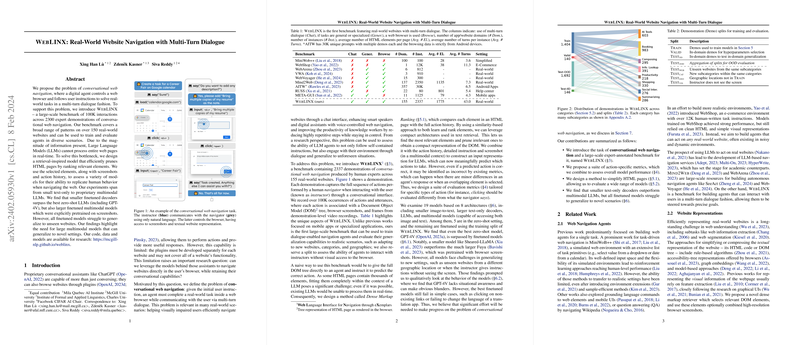Introduction
In the rapidly evolving field of conversational web navigation, researchers are pushing the boundaries to create digital agents that can navigate websites and perform tasks based on user instructions. The paper "WEB LINX: Real-World Website Navigation with Multi-Turn Dialogue" introduces an innovative approach to this problem. By leveraging LLMs and a unique method of efficiently parsing web pages, it marks a significant step forward in making digital agents more versatile and effective in handling real-world web navigation tasks.
Benchmarking Conversational Web Navigation
The core contribution of the paper is the introduction of WEB LINX, a comprehensive benchmark designed for training and evaluating agents on conversational web navigation tasks. It encompasses a vast dataset of 100K actions and utterances over 2300 expert demonstrations across 155 real-world websites, covering a broad spectrum of interaction patterns and scenarios.
One of the major challenges in conversational web navigation is efficiently understanding and manipulating the vast amount of information on web pages. Traditional approaches that directly feed entire HTML pages to LLMs are not feasible due to the models' input size limitations and the real-time processing requirement. To address this, the researchers developed a method akin to a retrieval system called Dense Markup Ranking (DMR), which prioritizes relevant webpage elements based on the dialogue's context. This enables the model to focus on pertinent parts of the page, improving efficiency and performance.
Evaluating Model Performance
The paper thoroughly evaluates various models, ranging from smaller text-only decoders to substantial multimodal LLMs capable of processing both text and visual inputs. The experiments reveal that smaller, fine-tuned decoders excel over larger zero-shot LLMs in task performance. However, all models struggle with generalizing to unseen websites and scenarios, highlighting the need for improvements in model robustness and adaptability.
One of the key findings is that even when fine-tuned, multimodal models like Fuyu-8B and GPT-4V do not outperform their text-only counterparts, suggesting current multimodal models might not be fully leveraging the additional visual information for these tasks. Moreover, the fine-tuned models significantly outperform their zero-shot counterparts, emphasizing the importance of task-specific fine-tuning.
Challenges and Future Directions
The paper underscores several challenges and potential areas for further research. Firstly, models need to better understand and act upon the dynamic elements of web pages, such as handling updates or changes in content after actions like clicks. Secondly, the authors identify the necessity for models to improve generalization to novel scenarios, which remains a significant hurdle.
Furthermore, the paper calls for advancements in multimodal models' ability to integrate textual and visual information more effectively. Despite the inclusion of screenshots and multimodal inputs, current models do not always translate this additional information into better performance, suggesting a gap in how these models process and utilize multimodal data.
Conclusion
"WEB LINX: Real-World Website Navigation with Multi-Turn Dialogue" makes an important contribution to the field of AI and conversational agents by presenting a robust benchmark for conversational web navigation and evaluating a range of models on this task. While highlighting the effectiveness of fine-tuned text-only decoders, it also outlines significant challenges that must be addressed to enhance the versatility and generalization capabilities of digital agents. The findings from this paper set the stage for future research into more advanced models that can seamlessly navigate the complex landscape of the web, making conversational agents more powerful and user-friendly.
